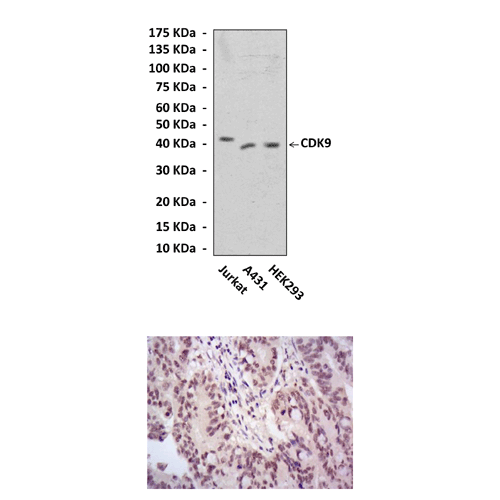Product Sheet CP10387
Description
BACKGROUND Cdks (cyclin-dependent kinases) are heteromeric serine/threonine kinases that control progression through the cell cycle in concert with their regulatory subunits, the cyclins. Although there are 12 different cdk genes, only 5 have been shown to directly drive the cell cycle (Cdk1, -2, -3, -4, and -6).1 Following extracellular mitogenic stimuli, cyclin D gene expression is upregulated. Cdk4 forms a complex with cyclin D and phosphorylates Rb protein, leading to liberation of the transcription factor E2F. E2F induces transcription of genes including cyclins A and E, DNA polymerase and thymidine kinase. Cdk4-cyclin E complexes form and initiate G1/S transition. Subsequently, Cdk1-cyclin B complexes form and induce G2/M phase transition. Cdk1-cyclin B activation induces the breakdown of the nuclear envelope and the initiation of mitosis.2 Cdks are constitutively expressed and are regulated by several kinases and phosphastases, including Wee1, CDK-activating kinase and Cdc25 phosphatase. In addition, cyclin expression is induced by molecular signals at specific points of the cell cycle, leading to activation of Cdks.3 Tight control of Cdks is essential as misregulation can induce unscheduled proliferation, and genomic and chromosomal instability. Cdk4 has been shown to be mutated in some types of cancer, whilst a chromosomal rearrangement can lead to Cdk6 overexpression in lymphoma, leukemia and melanoma. Cdks are currently under investigation as potential targets for antineoplastic therapy, but as Cdks are essential for driving each cell cycle phase, therapeutic strategies that block Cdk activity are unlikely to selectively target tumor cells.4
Cdk9 was known as important cell cycle regulators. This kinase was found to be a component of the multiprotein complex TAK/P-TEFb, which is an elongation factor for RNA polymerase II-directed transcription and functions by phosphorylating the C-terminal domain of the largest subunit of RNA polymerase II. This protein forms a complex with and is regulated by its regulatory subunit cyclin T or cyclin K. HIV-1 Tat protein was found to interact with this protein and cyclin T, which suggested a possible involvement of this protein in AIDS.5
Cdk9 was known as important cell cycle regulators. This kinase was found to be a component of the multiprotein complex TAK/P-TEFb, which is an elongation factor for RNA polymerase II-directed transcription and functions by phosphorylating the C-terminal domain of the largest subunit of RNA polymerase II. This protein forms a complex with and is regulated by its regulatory subunit cyclin T or cyclin K. HIV-1 Tat protein was found to interact with this protein and cyclin T, which suggested a possible involvement of this protein in AIDS.5
REFERENCES
1. Pestell, R.G. et al: Endocrine Rev. 20:501-34, 1999
2. Nurse, P.: Cell 100:71-8, 2000
3. Morgan, D. O.: Ann. Rev. Cell Develop. Biol. 13:261-91, 1997
4. McDonald, E.R. 3rd. & El-Deiry, W.S.: Int. J. Oncol. 16:871-86, 2000
5. Garber, M.E. et al: Mol. Cell. Biol. 20:6958-69, 2000
2. Nurse, P.: Cell 100:71-8, 2000
3. Morgan, D. O.: Ann. Rev. Cell Develop. Biol. 13:261-91, 1997
4. McDonald, E.R. 3rd. & El-Deiry, W.S.: Int. J. Oncol. 16:871-86, 2000
5. Garber, M.E. et al: Mol. Cell. Biol. 20:6958-69, 2000
Products are for research use only. They are not intended for human, animal, or diagnostic applications.
Details
Cat.No.: | CP10387 |
Antigen: | Raised against recombinant human CDK9 fragments expressed in E. coli. |
Isotype: | Mouse IgG1 |
Species & predicted species cross- reactivity ( ): | Human |
Applications & Suggested starting dilutions:* | WB 1:1000 IP n/d IHC 1:50 - 1:200 ICC n/d FACS n/d |
Predicted Molecular Weight of protein: | 40 kDa |
Specificity/Sensitivity: | Detects CDK9 proteins in various cell lysate. |
Storage: | Store at -20°C, 4°C for frequent use. Avoid repeated freeze-thaw cycles. |
*Optimal working dilutions must be determined by end user.
Products
| Product | Size | CAT.# | Price | Quantity |
|---|---|---|---|---|
| Mouse Cdk9 Antibody: Mouse Cdk9 Antibody | Size: 100 ul | CAT.#: CP10387 | Price: $457.00 |

